
- Index
- Brand
- Arabia (44)
- Aynsley (31)
- Bavaria (26)
- Denby (41)
- Frank M. Whiting (42)
- Limoges (47)
- Lomonosov (55)
- Noritake (61)
- Paragon (46)
- Portmeirion (29)
- Reed & Barton (29)
- Rosenthal (55)
- Royal Albert (132)
- Royal Doulton (49)
- Royal Worcester (37)
- Shelley (35)
- Susie Cooper (30)
- Unmarked (51)
- Villeroy & Boch (30)
- Wedgwood (99)
- Other (4292)
- Features
- 2 Tables (5)
- Airtight (8)
- Date-lined (7)
- Decorated (28)
- Decorative (63)
- Dishwasher Safe (20)
- Easy To Fill (4)
- Fixed (4)
- Flat Pack (23)
- Hand Painted (29)
- Handles (4)
- Lid Included (7)
- Mirrored (3)
- No Assembly Required (16)
- Set (3)
- Set With Tray (3)
- Tray (22)
- Vintage (6)
- With Handle (7)
- With Lid (4)
- Other (4995)
- Material
- Bakelite (15)
- Bone China (406)
- Brass (18)
- Ceramic (342)
- Ceramic & Porcelain (40)
- Ceramic, Porcelain (31)
- China (18)
- Copper (18)
- Earthenware (40)
- Fine Bone China (22)
- Glass (80)
- Ironstone (24)
- Metal (34)
- Porcelain (701)
- Porcelain / China (443)
- Porzellan (47)
- Pottery (28)
- Silver Plate (27)
- Stoneware (105)
- Wood (27)
- Other (2795)
- Model
- Blue Flower (10)
- Camellia (3)
- Chocolate Set (4)
- Coffee (6)
- Coffee Set (38)
- Coronation (4)
- Cup & Saucer Set (10)
- Dainty Blue (3)
- Folk Love (3)
- Honor (3)
- Jasperware (11)
- Ludlow (3)
- Perco Retro Classic (7)
- Romance (4)
- Rose And Red Daisy (6)
- Thanksgiving (4)
- Traditional (5)
- V1926 (6)
- Vintage (11)
- 1410 (4)
- Other (5116)
- Type
- Canister Set (15)
- Coffee / Tea Set (168)
- Coffee Cup (62)
- Coffee Cup & Saucer (400)
- Coffee Mug Set (14)
- Coffee Pot (108)
- Coffee Set (381)
- Coffee Table (27)
- Complete Coffee Set (19)
- Cup (47)
- Cup & Saucer (118)
- Cup & Saucer Set (33)
- Dinner Service (19)
- Set (18)
- Tables (55)
- Tea / Coffee Set (30)
- Tea Cup (16)
- Tea Cup & Saucer (124)
- Tea Set (277)
- Teapots & Tea Sets (17)
- Other (3313)
- Vintage
Vintage Meissen Strewn Flowers B-Form 3 Piece Coffee Set Cup, Saucer, & Plate
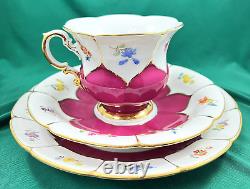
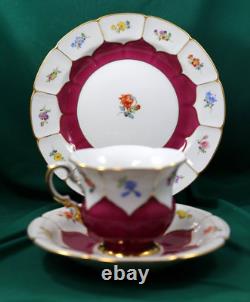
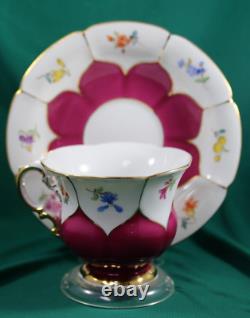
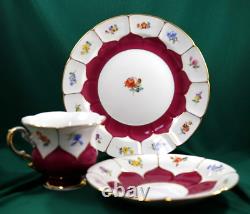
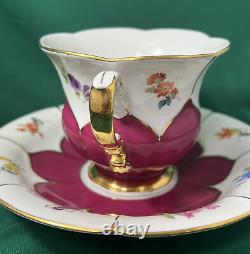
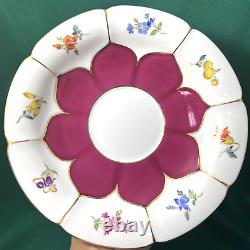
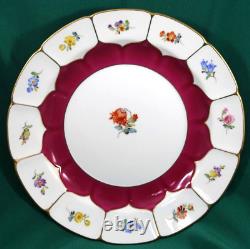
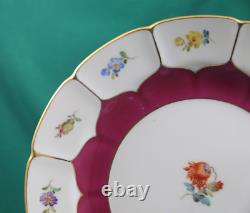
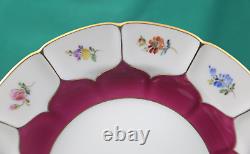
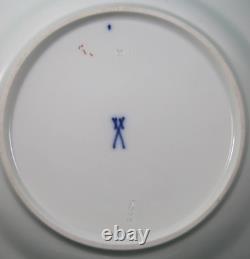
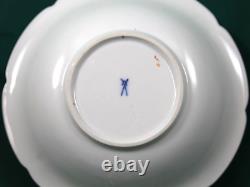
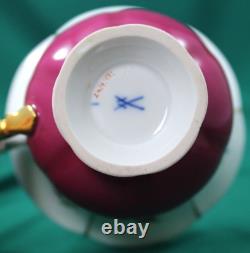


Vintage Meissen Strewn Flowers Crimson & Gold B-Form 3 Piece Coffee Set. Cup Height: 3.15 in. Cup Width: 4.5 in. Saucer Width: 6.5 in.
Plate Width: 7.5 in. Overall in Very GOOD Condition. Coffee Cup has no imperfections. The Saucer has some gold slightly removed in some parts not very noticeable though. Lastly the plate the gold is intact throughout however the crimson color is slightly removed in some sections of the plate.Please see all pictures provided. Meissen Porcelain (Staatliche Porzellan-Manufaktur Meissen) is one of the preeminent porcelain factories in Europe and was the first to produce true porcelain outside of Asia.
In pursuing his passion, which he termed his "maladie de porcelaine, " Augustus spent vast sums, amassing some 20,000 pieces of Japanese and Chinese ceramics. These, along with examples of early Meissen, comprise the Porzellansammlung, or porcelain collection, of the Zwinger Palace, in Dresden. The king was determined, however, to free the European market from its dependence on Asian imports and to give European artisans the freedom to create their own porcelain designs.To this end, he charged the scientist Ehrenfried Walther von Tschirnhaus and aspiring alchemist Johann Friedrich Böttger with the task of using local materials to produce true, hard-paste porcelain (as opposed to the soft-paste variety European ceramists in the Netherlands, Germany, France, Italy and Spain had been producing since the late Renaissance). In 1709, the pair succeeded in doing just that, employing kaolin, or china clay. A year later, the Meissen factory was born. In its first decades, Meissen mostly looked to Asian models, producing wares based on Japanese Kakiemon ceramics and pieces with Chinese-inflected decorations called chinoiserie.
During the 1720s its painters drew inspiration from the works of Watteau, and the scenes of courtly life, fruits and flowers that adorned fashionable textiles and wallpaper. It was in this period that Meissen introduced its famous cobalt-blue crossed swords logo - derived from the arms of the Elector of Saxony as Arch-Marshal of the Holy Roman Empire - to distinguish its products from those of competing factories that were beginning to spring up around Europe. By the 1730s, Meissen's modelers and decorators had mastered the style of Asian ceramics, and Augustus encouraged them to develop a new, original aesthetic. The factory's director, Count Heinrich von Brühl, used Johann Wilhelm Weinmann's botanical drawings as the basis for a new line of wares with European-style surface decoration. The Blue Onion pattern (Zwiebelmuster), first produced in 1739, melded Asian and European influences, closely following patterns used in Chinese underglaze-blue porcelain, but replacing exotic flora and fruits with Western varieties (likely peaches and pomegranates, not onions) along with peonies and asters. During the same period, head modeler Joachim Kändler (1706-75) began crafting delicate porcelain figures derived from the Italian commedia dell'arte. Often used as centerpieces on banquet tables and decorated to reflect the latest fashions in courtly dress for men and women, these figurines were popular in their day, and are still considered among Meissen's most iconic creations. Kändler also created the Swan Service, which, with its complex low-relief surface design and minimal decoration is considered a masterpiece of Baroque ceramics.The rise of Neoclassicism in the latter half of the 18th century forced Meissen to change artistic direction and begin producing monumental vases, clocks, chandeliers and candelabra. In the 20th century, Meissen added to its 18th-century repertoire decidedly modern designs, including ones in the Art Nouveau style. Starting in 1933, artistic freedom was limited at the factory under the Nazi regime, and after World War II, when the region became part of East Germany, it struggled to reconcile its elite past with the values of the Communist government.
In 1969, however, new artistic director Karl Petermann reintroduced the early designs and fostered a new degree of artistic license. Meissen became one of the few companies to prosper in East Germany. Owned by the State of Saxony since reunification, in 1990, Meissen continues to produce its classic designs together with new ones developed collaboratively with artists from all over the world. In addition, through its artCAMPUS program, the factory has invited distinguished ceramic artists, such as Chris Antemann and Arlene Shechet, to work in its studios in collaboration with its skilled modelers and painters. The resulting works of contemporary sculpture are inspired by Meissen's rich and complex legacy.PLEASE REFER TO ALL THE PHOTOS. Let us know if you have any questions or specific photo requests. We strive for accuracy in describing every item. Please remember that most of the items that we carry have been previously owned. Unless otherwise stated, they may not be in absolutely flawless condition.
We include very detailed pictures and give accurate written descriptions... Please pay particular attention to the sizes and measurements. It will be in the same condition, as it is described within the description, along with photos.
Only the item(s) within the photos are what you will receive. By purchasing this item, you agree to all of the terms and conditions listed. TRADERS LOAN & JEWELRY EST.

